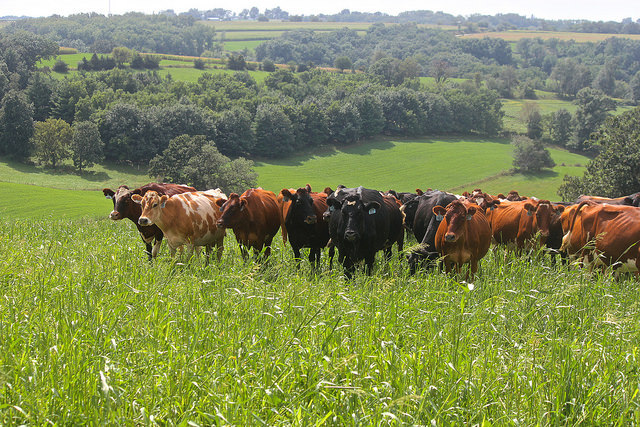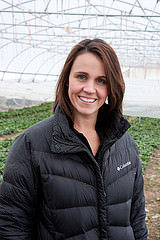Pasture partnership supports organic dairy farmers across Wisconsin

Grazing dairy cows at Organic Valley sponsored pasture walk. Courtesy Anders Gurda
Not all pastures are created equal. Some have a diverse mix of grasses and legumes. Others can be dominated by a single grass species or overrun with weeds.
In an effort to help improve the health of pastures owned by dairy farmers across Wisconsin and beyond, University of Wisconsin–Madison researchers have established a partnership with Organic Valley, the nation’s largest organic farming cooperative, to study how to make pastures as productive, nutritious and sustainable as possible.
The project was sparked by changes made in 2010 to federal regulations governing organic dairy operations, which put more emphasis on the role of pasture in the dairy cow diet.
“The regulation states that at least 30 percent of the animals’ dry matter intake during the grazing season has to come from pasture. That was a significant shift for some farmers,” says Erin Silva, UW–Madison assistant professor of plant pathology and UW-Extension organic production systems specialist.

Erin Silva
The new rules are particularly relevant to Wisconsin. The state ranks first in the nation for the number of organic dairy farms. It is also the home of Organic Valley, headquartered in La Farge, which generated over $1 billion in sales last year and has more than 640 farmer-members in the state and another 1,160 across the nation.
“Because we as a co-op are about 80 percent dairy producers, we are very pasture-centric,” says Logan Peterman, farm resource manager for Organic Valley. “So the new regulations gave us a big incentive to improve pasture productivity per acre.”
To help address this need, Peterman reached out to Silva, head of the university’s Organic and Sustainable Agriculture Research and Extension Program. In that role, Silva leads an ever-expanding research and outreach program that includes vegetables, row crops and pastures.
“Pasture is a whole new world for me,” she says, “but dairy is such an important part of the organic industry in the state — in terms of economic value and impact — that it makes sense I would get pulled into this area.”
In response to Peterman’s request, Silva assembled a large, multidisciplinary team of UW–Madison experts with experience in dairy grazing, agronomy, weeds, plant diseases, soil fertility and more to help develop a research plan. In a 2012 gathering that Silva dubbed the “organic pasture summit,” the UW team met with Peterman and some of his Organic Valley colleagues to discuss approaches and make sure the results would be helpful to farmers.
“It’s great to be connected to an industry partner to make sure where we’re going is relevant,” notes Silva.
The group decided to start by conducting a survey to get a current snapshot of pasture health on Organic Valley farms, since the baseline information would be valuable to the university and the cooperative alike. With funding from the Ceres Trust, Silva’s team surveyed 20 Organic Valley farms recruited with Peterman’s help. While the numbers are still in the process of being crunched, some preliminary trends have already emerged.
“It’s great to be connected to an industry partner to make sure where we’re going is relevant.”
Erin Silva
“We found there was a significant degree of diversity with respect to pasture quality, as well as soil quality, on these farms,” says Silva. “The results highlight the importance of soil testing and managing the pasture soil fertility appropriately,” something that can be as easy as adding a soil fertility amendment or increasing the diversity of pasture plants growing in a field.
The findings have also revealed some expected and some unexpected connections between various pasture management practices and pasture health, says Peterman, “whereas in the past, we only had anecdotal information from farmers.”
The results will soon be used by Peterman and Organic Valley field advisors to help the cooperative’s dairy farmers get more out of their pastures in a sustainable way, with the goal of helping to improve the productivity of their dairy operations — and their bottom lines.
“Now, when my team is out visiting farms, we can make assessments on the spot,” says Peterman. “Change is hard, and benchmarks are a good way to help farmers discern whether improving their pasture is worth their time and effort.”
The benefits of this work will extend to organic dairy producers across the state and beyond, through Silva’s various extension activities. “The issues that Organic Valley farmers face are similar, if not identical, to those faced by other farmers across Wisconsin and the upper Midwest,” she says. “So the best management practices that come from this work will apply quite broadly.”
Subscribe to Wisconsin Ideas
Want more stories of the Wisconsin Idea in action? Sign-up for our monthly e-newsletter highlighting how Badgers are taking their education and research beyond the boundaries of the classroom to improve lives.




